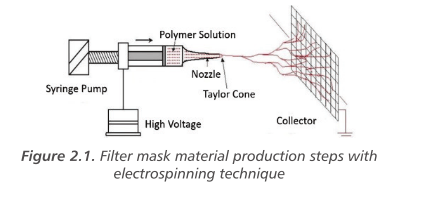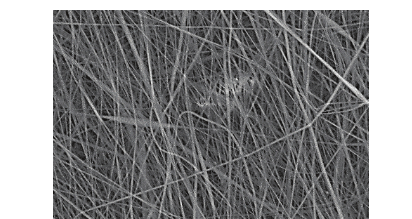1. Introduction
Polylactic Acid (PLA) is an environmentally friendly thermoplastic polymer. Aliphatic polyesters, such as PLA, are a biocompatible polymer with mechanical properties, transparency and non-toxic properties. With these features, it is used in consumer products such as packaging, automobile, furniture, food, textile and pharmaceutical industry. The chemical formula of PLA (C3H4O2 as n [1].
As a consumer product produced using PLA; clothes, utensils and food packages. PLA, diapers, feminine hygiene products, medical sutures, stents and pharmaceutical applications used in the medical industry can also be used [1-3].
In this study, it is provided to produce mats produced using nanotechnological electrospinning technique as mask material with a filtering feature against viruses and bacteria.
2. Materials and Methods
2.1 Used Materials
10-15 kDa polylactic acid (PLA) from Kocaeli University Faculty of Engineering Chemical Engineering Department, dimethylformamide (DMF) organic solvent and greaseproof paper for substrate to dissolve the polymer.
2.2 Filter Production with Electrospinning Technique
10% PLA polymer solution was prepared according to the desired temperature and mixing speed with the help of a magnetic stirrer [3-5]. The production stages of filter mask material with electrospinning technique are given in Figure 2.1.

2.3 Characterization Studies
The tissues placed in the holders were examined and photographed with the FEI FEG QUANTA 450 SEM microscope. During the examination of the diameters and dimensions of the nanofibers of the filters produced, images with x6000 times magnification were examined for the Field Emission Gun Scanning Electron Microscope (FEGSEM) analysis at a potential of 10 kV. The nanofibers in the filter materials produced were determined by measurements on the FEI FEG QUANTA 450 device. Average diameter thicknesses of nanofibers were measured on high resolution FEGSEM photographs using Image j (National Health Organization) software [1-6].
3. Discussion
3.1 FEGSEM Analysis
Nanofiber diameters of PLA mats were determined by FEGSEM analysis. 40 nanofiber measurements were measured on the image at x6000 magnification. It was also determined that fibers with an average range of 50-125 nanometers (nm) and oriented tight fibers were found [2-4]. 10% PLA x6000 FEGSEM image takes place in Figure 3.1.

Figure 3.1. 10% PLA x6000 FEGSEM image
4. Conclusion
The average fiber diameters of the produced PLA mats were measured to be 50-125 nanometers. Based on the results of the study, an ideal filter material feature will be provided by providing the barrier duty of the PLA mats prepared against viruses and bacteria.
References
1. Buluş, E. (2017). Doğal izole edilmiş biyoseramiklerden elektrospinning yöntemi ile polimerik biyokompozit malzeme eldesi/Polymeric biocomposite material production from naturally isolated bioceramics via electrospinning method.
2. Duymaz, B. T., Erdiler, F. B., Alan, T., Aydogdu, M. O., Inan, A. T., Ekren, N., … & Selvi, S. S. (2019). 3D bioprinting of levan/polycaprolactone/gelatin blends for bone tissue engineering: Characterization of the cellular behavior. European Polymer Journal, 119, 426-437.
3. Bulus, E., Sahin, Y. M., Darici, H., & Sener, L. T. Investigation of the Cellular Behavior of Polycaprolactone-Hydroxyapatite Tissue Materials Produced with Bioprinter.
4. Bulus, E., İsmik, D., Mansuroglu, D. S., Sahin, Y. M., & Tosun, G. (2017, April). Synthesis and characterization of hydroxyapatite powders from eggshell for functional biomedical application. In 2017 Electric Electronics, Computer Science, Biomedical Engineerings’ Meeting (EBBT) (pp. 1-3). IEEE.
5. Yıldırım, D., Buluş, E., Özcan, S., Doğancı, E., Doğancı, M. D., Şahin, Y. M., … & Dursun, E. N. Antioksidan Özellikli Siyah Pirinç-Poliüretan Biyokompozitinin Gıda Ambalajlama Ve Yara İyileştirici Ürünü Olarak Eldesi. 6. Buluş, E., Mansıroğlu, D. S., Ismık, D., Şahin, Y. M., Oktar, F. N., Gündüz, O., & Gökçe, H. (2018, April). Bioceramic synthesis and characterization to be used in major tissue engineering applications. In 2018 Electric Electronics, Computer Science, Biomedical Engineerings’ Meeting (EBBT) (pp. 1-4). IEEE.

Erdi Buluş
Metallurgical and Materials High Engineer
Material Technologies Specialist
Istanbul Arel University ArelPOTKAM
(Polymer Technologies and Composite Application and Research Center)
Gülseren Sakarya Buluş
Specialist Nurse
Silivri District Health Directorate





